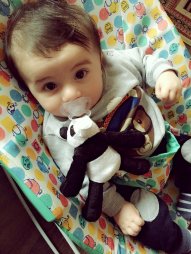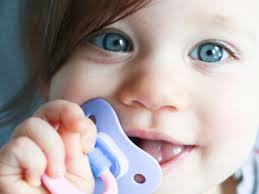How Does A Pacifier Works?
A strong suckling reflex is common to most babies. In fact, many babies are known to practice sucking the thumb or their fingers even before they are born. Sucking, apart from providing nutrition to babies, also gives them a feeling of familiarity, calmness and that is why some parents will always have a binky in their baby bags. Some babies are satisfied to suck during feeding and get settled with cuddles or rocking arms, while others can’t seem to have had enough-even though they aren’t hungry. It is at these times pacifiers will be the right thing if your baby still needs to suck after she’s had her milk.
What Are Pacifiers Made Of?
Pacifiers generally have three parts: the nipple, the guard -which rests on the baby’s lips and the ring attached to the center of the guard. Artificial nipples are always made of a material that closely simulates a mother’s nipple. It is usually of latex or silicone and is occasionally of hard plastic. The guard is firmly attached to the nipple and prevents ingestion of the nipple by the child. Increasingly, pacifier manufacturers believe that the nipple and mouth guard should be of one material and molded together so that the two do not have to be fused during the manufacturing process. This guard must have holes in it to ensure that in the event of ingesting the guard the holes permit air to pass through to the windpipe. Finally, the ring at the center of the guard must be present in order to pull the pacifier forcibly from the mouth in the event of ingestion.
Should I Give My Baby A Pacifier?
As a new parent, comforting your baby is one of your highest priorities, and you may find a pacifier very helpful. Some babies can be soothed with rocking and cuddling and are content to suck only during feedings. Others just can’t seem to suckle enough, even when they’re not hungry. If your baby still wants to suck after she’s had her fill of formula or breast milk, a pacifier may be just the thing. A pacifier is not a substitute for nurturing or feeding, of course, but if your baby is still fussy after you have fed, burped, cuddled, rocked, and played with her, you might want to see if a pacifier will satisfy her.
Pacifier Do’s and Don’ts
If you choose to offer your baby a pacifier, keep these tips in mind:
- Wait until breast-feeding is well-established. If you’re breast-feeding, the American Academy of Pediatrics recommends waiting to offer a pacifier until your baby is 3 to 4 weeks old, and you’ve settled into an effective nursing routine.
- Don’t use a pacifier as a first line of defense. Sometimes a change of position or a rocking session can calm a crying baby. Offer a pacifier to your baby only after or between feedings.
- Choose the silicone one-piece, dishwasher-safe variety.Pacifiers made of two pieces pose a choking hazard if they break. Once you’ve settled on a favorite pacifier, keep a few identical backups on hand.
- Let your baby set the pace. If your baby’s not interested in the pacifier, don’t force it. If the pacifier falls out of your baby’s mouth while he or she is sleeping, don’t pop it back in.
- Keep it clean. Before you offer your baby a pacifier, clean it thoroughly. Until your baby is 6 months old and his or her immune system matures, frequently boil pacifiers or run them through the dishwasher. After age 6 months, simply wash pacifiers with soap and water. Resist the temptation to “rinse” the pacifier in your own mouth. You’ll only spread more germs to your baby.
- Don’t sugarcoat it. Don’t put sweet substances on the pacifier.
- Keep it safe. Replace pacifiers often, use the appropriate size for your baby’s age, and watch for loose parts or signs of deterioration. Also use caution with pacifier clips. Never use a string or strap long enough to get caught around your baby’s neck.



